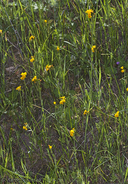notes This photo shows a back-lit frontal view of the inflorescence of a ''partial homostyle'' type plant of Amsinckia lunaris. Note the three anthers visible in the throat here. The stigma-tipped style and two more anthers are situated lower in the corolla tube. (A true ''thrum'' type flower in A. lunaris has all 5 anthers above the style tip and visible in the throat...see below for details.) The plants here were found growing in a grassy opening in chaparral/oak woodland on a steep, north-facing slope. I'm grateful to Chris Thayer for showing me these rare plants.
Among the diagnostic characters for this species are: 1) all 5 calyx lobes distinct and of roughly the same width (as opposed to having one or two pairs fused and thus appearing wider, as in some other species); 2) leaves not succulent, margin entire; 3) corolla with two darker red spots on 'lower lip', and limb of corolla obliquely angled (rather than perpendicular) to the tube. [Note: In the literature, it seems this last character is confusingly referred to using the phrase ''corolla tube bent''. But the corolla tube itself is straight! It's the plane of the corolla lobes that appears ''bent'' relative to the tube (in profile).]
An interesting aspect of A. lunaris, pointed out to me by Chris, is heterostyly of its flowers. Depending on the species, Amsinckia can have different types of flowers (but all are of one type per plant). Typical 'homostylous flowers' have the style tip at roughly the same height as the anthers...but there are also ''pin'' flowers with the style tip above the anthers (and typically peeking out of the throat); as well as ''thrum'' flowers with anthers high in the throat and the style tip well below (see A and B in the figure here). According to the Jepson eFlora Amsinckia treatment there are 12 currently recognized species: 7 of them are entirely homostylous; and 5 of them are heterostylous (i.e. with both pin and thrum plants present in typical situations). The 5 heterostylous species are douglasiana, grandiflora, furcata, lunaris, and spectabilis. The Jepson eFlora indicates some of these species can also have homostylous flowers present in certain populations.
In the field I initially thought we were seeing both ''pins'' and ''thrums''. But now, after studying the 1957 paper by Ray & Chisaki, it seems to me what I actually photographed were ''pins'' and ''partial homostyles''. According to Ray & Chisaki (see their Fig. 4 on pg. 534), true thrums of A. lunaris have all 5 anthers positioned near the top of the tube/throat; whereas ''partial homostyles'' have 3 anthers in the throat and 2 lower in the tube at the same height as the style tip. I only see 3 anthers in the throats in my ''non-pin'' images. I believe Barry Rice's post here shows a true thrum of A. lunaris with 5 anthers in the throat. The one population Ray & Chisaki gave details on had 31 thrums, 88 pins, and 99 partial homostyles. Thus the ratio of partial homostyles to true thrums in that population was more than 3-to-1, so it seems plausible that in our population a random sample of what we thought were thrums were mostly partial homostyles...and that's all I appear to have gotten photos of.
A 1976 paper by Ornduff explores distyly in A. grandiflora, where there are just two type of flowers: pins and thrums.
The 1997 paper here suggests that the 5 (relatively rare and larger-flowered) heterostylous species of Amsinckia are phylogenetiically 'older' taxa, and that the other 7 homostylous species have become much more abundant (and functionally weedy!) through the evolutionary loss of heterostyly and the attendant increase in fecundity due to the resulting ability to prolifically self-fertilize.






